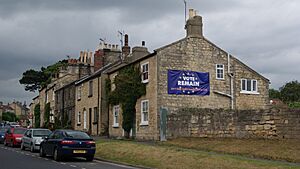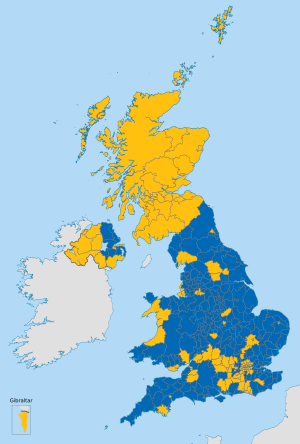United Kingdom European Union membership referendum facts for kids

On 23 June 2016, people in the United Kingdom and Gibraltar voted in a special election called a referendum. They had to decide if the UK should stay in the European Union (EU) or leave it. Most people, 51.9%, voted to leave the EU.
The day after the vote, on 24 June, the Prime Minister at the time, David Cameron, said he would step down. Theresa May took over as Prime Minister on 13 July.
Contents
What Was the Referendum About?
A referendum is like a big vote where everyone in a country can have their say on a very important question. In this case, the question was about the UK's membership in the European Union. The EU is a group of countries in Europe that work together on things like trade, laws, and how people can travel between countries.
The Remain Campaign: Staying in the EU
The Remain campaign wanted the United Kingdom to stay part of the European Union. Many political groups supported this, including the Labour Party, the Liberal Democrats, and the Scottish National Party.
They believed that being in the EU brought many benefits to the UK, especially for trade. They thought it helped the UK's economy and made it easier to do business with other European countries. Prime Minister David Cameron also supported staying in the EU. Other well-known politicians who wanted to remain included George Osborne, Theresa May, and Philip Hammond.
The Leave Campaign: Leaving the EU
The Leave campaign, often called Brexit, wanted the UK to leave the European Union. Political groups like the UK Independence Party and many members of the Conservative Party supported this idea.
People who wanted to leave were especially worried about the EU's "open border" rules. These rules allow people to move freely between EU countries. They were also concerned about the number of people moving into the UK from other EU countries. Some famous Conservative politicians who wanted to leave the EU were Iain Duncan Smith, Michael Gove, and Boris Johnson.
How the Votes Turned Out
Here's a quick look at the final results:
| United Kingdom European Union membership referendum, 2016 | ||
|---|---|---|
| Choice | Votes | % |
| Remain a member of the European Union | 16,141,241 | 48.11 |
| Leave the European Union | 17,410,742 | 51.89 |
| Total votes | 33,551,983 | 100.00 |
* These numbers are for valid votes only. About 25,359 votes were not counted because they were invalid or blank.
When we look at different parts of the UK, we can see some areas voted differently. For example, London, Northern Ireland, and Scotland mostly voted to Remain in the EU. However, most other regions in England and Wales voted to Leave.
What Happened After the Vote?
Soon after the results were announced, David Cameron said he would step down as Prime Minister. After a new leader was chosen, Theresa May became Prime Minister on 13 July 2016.
The Scottish government announced they might hold another vote to decide if Scotland should become an independent country. A politician from Northern Ireland, Martin McGuinness, also suggested a vote for Northern Ireland to join with the Republic of Ireland. There was even a group that wanted London to become independent, and thousands of people signed an online petition for it.
Some people also started a petition asking for a second referendum on EU membership. This petition got over two and a half million signatures. However, the government later said no to holding another vote.
On 29 March 2017, Theresa May officially started the process for the UK to leave the EU. This is called "triggering Article 50." It meant that talks began between the UK government and the European Union about how they would separate. These talks were expected to last for two years, after which the UK would officially leave the EU.
Images for kids
-
Boris Johnson was a key leader in the Leave campaign.
-
A protest in Manchester by people who wanted the UK to stay in the EU.
See also
 In Spanish: Referéndum sobre la pertenencia del Reino Unido a la Unión Europea para niños
In Spanish: Referéndum sobre la pertenencia del Reino Unido a la Unión Europea para niños









